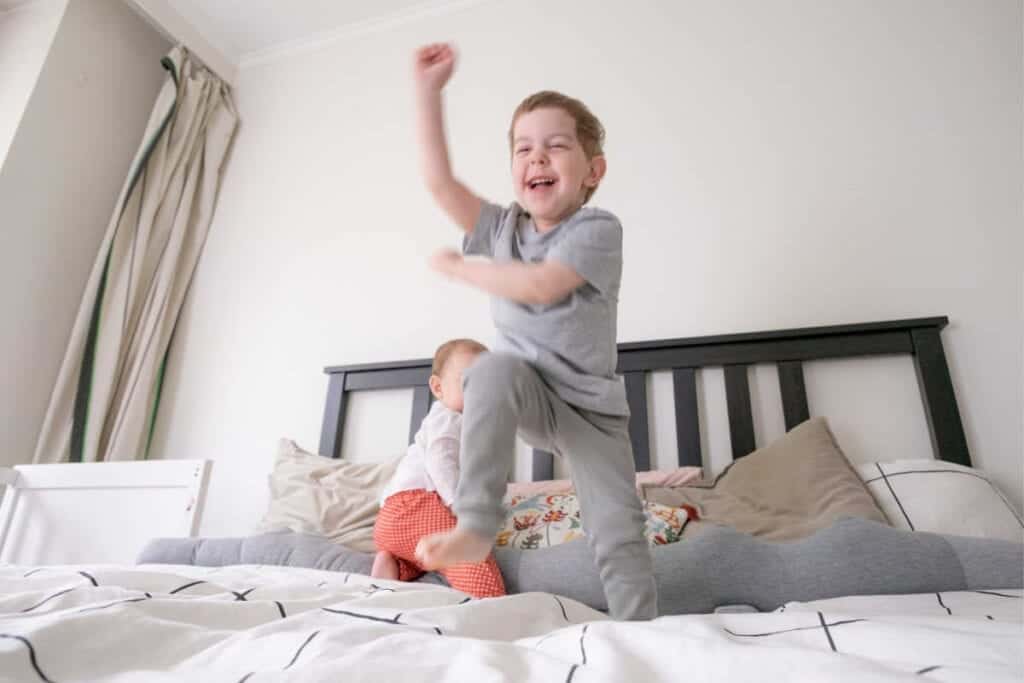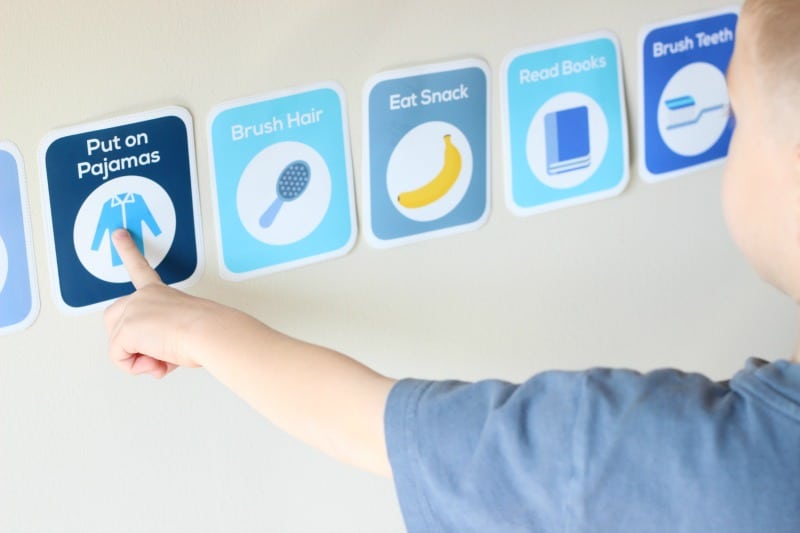Inside:Are you struggling answer the question, “How to put a toddler to sleep fast?” After helping frustrated and exhausted parents for years, I’ve put my best kept secrets into one list for helping toddlers fall asleep faster than ever.
Our bedtime battle reached the two hour mark. Round after round, my toddler daughter and I battled about her going to bed. I wanted her to sleep, and for two hours, she tried to prove me wrong.
One night, I even took pictures of her little fingers sticking out the bottom of the bedroom door pleading with me to stay awake. I knew one day (probably 20 years later) this picture would bring a smile to my face. But that night, nothing was funny to me.
That was months ago. In a few weeks time, we went from knock-down, drag-out battles to peaceful and cooperative bedtimes using a few different techniques.
Here’s even better news.
No matter if your toddler keeps getting out of bed, or your dealing with toddler tantrums at bedtime or something else, there is hope. I’m a firm believer that all kids are capable of going to bed peacefully and on their own. It’s only a matter of helping them see their abilities.

How to put a toddler to sleep fast.
Over the years, I’ve worked with countless parents struggling with toddlers sleep issues. I’ve put together my top seven best secrets for helping your toddler find their Inner Sleep Goddess. The best part? You can do this all without yelling, threatening or bribing your toddler to fall asleep fast.
Related: 2 Year Old Sleep Regression Explained. Why It Happens and Solutions.
1. Fill the needs: power, experience, connection.
All kids have three basic needs: power, experience and connection. Everything your child is already doing is meeting those needs (This is part of Language of Listening® – the three-part parenting framework I use).
When kids want to connect, they will fight bedtime and continue to come out of bed in order to connect. If kids feel powerless and desire control, they will fight bedtime in order to fill their need for power. And if kids want the experience of sleeping in your bed, they will continue trying to experience it if they don’t see another alternative.
In order to help your child meet his or her need for connection, use SAY WHAT YOU SEE®.
This is a technique where you describe what the child is doing, saying, feeling or thinking. This is the step of validation and connection for kids. If you don’t know what to say, a wonderful default I love to use is, “You wanted…” and then add in what the child wants, or wishes for in that moment. The more you use SAY WHAT YOU SEE with your kids, the more your child will feel heard and understood. When a child feels heard, he or she feels connected to you.
Related: Two words that will tame temper tantrums – every time.
If order to help your child meet his or her need for power, look for things your child CAN DO to feel in control.
Meeting a child’s need for power is often overlooked, but it is usually the primary need at the beginning of a bedtime battle because children feel powerless when they can’t get what they want. This might be choosing the pajamas they wear, the order of the bedtime routine, the books you read, or the game you play during teeth brushing. When kids feel in control, they stop trying to control others.

To help your child meet his or her need for experience, grant your child’s wishes in fantasy.
“You wish statements” help meet your child’s need for experiencein fantasy when he or she wants something and can’t have it. The more detail you add, the more it will feel to the child.
It might sound something like this: “You wish you could stay up with mom. You wish you could stay awake, come down stairs, eat a big bowl of ice cream with sprinkles and watch TV. You’d love to stay awake all night long and never go to sleep for 1,000 nights.”
2. Play out struggles using games.

Children don’t say, ‘I had a hard day […] Can we talk?’ They say, ‘Will you play with me?’” – Lawrence Cohen.
Using play is a powerful tool to help your child stop using behaviors you don’t like and start using ones that you do. If your toddler keeps coming out of bed or your toddler keeps waking up at night or if you can’t figure out how to put a toddler to sleep fast, turn it into a game.
Allow your child to play the role of the parent while you play the role of the child. Play your game during the day or long before it’s bedtime.
- Have your child tell you to stay in bed and stop coming out.
- Then cry in the room and try to sneak out.
- Allow your child to find you and put you back to bed.
- Follow the child’s lead with the game; let the child take you where they need to go.
Kids know exactly what they need and will meet their needs (power, experience, connection) through play. Keep a close eye on how your child acts out the parent role — that’s likely how they perceive you during bedtime. You’ll know kids are on their way to meeting their own needs when they ask to play the child role again. Continue playing the game on a regular basis until the child asks to stop.
3. Use a visual routine – especially with toddlers.
“In a largestudyacross several countries, researchers found that having a consistent bedtime routine is directly related to better sleep:Children who had a regular bedtime routine fell asleepfaster, had anearlier bedtime, had fewer night wakingsand slept longerthan children who did not have a regular bedtime routine!

The relationship between having a bedtime routine and sleep was dose-dependent, meaning that the younger the child was when the routine was started, and for each additional night that the bedtime routine was used, the better the quality of sleep for the child.” — Ashley Soderland, Nurture and Thrive
You can add another layer to your toddler’s routine using a daily printable schedule for kids. When toddlers see the routine, they are more cooperative and able to follow along. Eventually toddlers begin to follow the routine with less and less prompting, saving time!
4. Diffuse essentials oils for sleep support.
There are many different essential oils for sleep support, but for kids, my favorites are cedarwood and lavender. Cedarwood essential oil supports healthy function of the pineal gland, which releases melatonin…the body’s natural sleepy hormones.
Lavender is well-known for it’s relaxing and calming effects on the body. The reason I love this oil most is it’s safe to use on all ages–babies through adults. Before choosing an essential oil brand, be sure to extensively research purity standards. You definitely don’t want to put adulterated oils on your kids (they are stuffed with chemical fillers).
One more that we love is called Tranquil. It’s a roll-on which makes it convenient and easy. I’ll frequently roll in onto my daughter’s wrists if she has trouble going to bed or falling asleep after a night-waking.
5. Treat sleep as a gift, not a punishment.
Parents can often fall into the trap of using sleep as a punishment: “That’s it! If you don’t clean up the toys right now, you’re going to bed!”
If our son wouldn’t pick up the toys before bed, the consequence was not sleep. There was no more, “You’re going to bed right now.” Instead, if he didn’t pick up the toys, he lost the toys the next day. That was just the rule.
Look for ways to re-frame your bedtime routine as a very special time with mom or dad.
- “It’s your special time with mommy (or daddy).”
- “It’s your snuggle time. We get our bodies clean, comfy and cozy.”
- “Snuggle time feels so good!”
Then talk to your child about ways sleep benefits the brain and body, using language they can understand.
- “Did you know the more you sleep, the faster you will be able to run and play?”
- “When you sleep, your brain moves all the things you learned today into the right spot!”
- “Did you know that you need more sleep than mommy (or daddy) because your brain and body is growing super fast?”
- “Sleep helps heal all your boo-boos faster than if you didn’t sleep!”
Read more here: How to handle bedtime tantrums.
6. Use Success Training to help your child stay in bed.
Success Training is another tool from Language of Listening that I love to use. To help a child learn to stay in bed, it might go something like this:
After going through your initial bedtime routine, start by offering to let your child set a time for you to check on him or her (like in 2-5 minutes) so she can experience success in staying alone and in bed, set a timer, and return on time a couple of times.

Each time point out a STRENGTH — any little thing she did right–you didn’t move (stayed under the covers, on your bed, in your room like you said below) that whole time! After a couple of successes, point out that shows she trusts you to come back noting how long she stayed in his bed and how hard that must be since this is a new routine.
Then see if she is ready to try another minute between visits (or 2 or 5 depending on how quickly she is adapting to this new routine), and try that a couple of times. Keep checking and extending until she is asleep. The first few nights it will take A LOT of your time, but you should see progress every night.
As your child’s confidence grows, she will choose a longer time between visits, and you will know she is on her way to going to sleep on her own without a struggle. If she comes out before the time of the visit, she may not believe you right away or may be worried you is tricking her. If so, you can adjust the time down until you find the success point and restart there. It may go back a forth a while at first before seeing steady progress.
Each time she finds a way to stay in bed or stay calm, name those STRENGTHs. Coaching your child, she can start to help herself through the situation.
- “You stayed in your room for a while even though you didn’t want to.”
- “You found a way to stay calm at bedtime. That took a lot of self-control!”
7. Explore fears at bedtime, rather than ignore them.
When kids are afraid of something, and they hear, “There’s nothing to be afraid of. You’re fine!” it creates a disconnect. In an effort to feel heard and understood, the child will intensify his communication to prove to you his fears are very real.
The only way to help a child truly move past fear is to validate the feeling.
“You saw monsters in your room somewhere. And wow, that just really stuck with you. There’s something about it that you can’t let go. And you want to feel comfortable. Right now, you think the only thing that will help you feel comfortable is me laying down next to you and sleeping. Hmmmm….there must be something we can do to help you feel comfortable AND fall asleep on your own.”
Follow the child’s lead, validate the emotions (no matter how illogical it seems).
Read more here: How to respond when your child’s afraid to sleep alone.
There’s more.
Learning how to put a toddler to sleep fast is a huge challenge. Every child is different, which means that there is no right or wrong answer when finding solutions.
We’ve used a combination of the above on and off with our kids when needed. After only a few weeks time, our daughter was back on track, cheerfully participating in her bedtime routine and peacefully falling asleep on her own.
And remember…it’s only a sleep problem if it’s a sleep problem for you. Try different things and see what feels right to you. Trust your gut.
Print this free toddler listening checklist.
This post comes with a free printable checklist to help with toddler listening. I always have the hardest time remembering these phrases. This printable simplifies it!
Here is a sneak preview…
Download Your Free Printable
- Download the checklist. You’ll get the printable, plus join 37,000+ parents who receive my weekly parenting tips and ideas!
- Print. Any paper will do the trick, but card stock
would be ideal.
- Place it on your refrigerator. Check things off as you go and don’t forget a thing!
Want more on toddlers?
- 2 Year Old Not Listening? Try This Remarkable Tip
- How to Get Your Child to Follow a Routine Without Reminders
- Top 7 Challenges (And Solutions) For Parenting a Newborn and Toddler
- 5 Sample Daily Toddler Schedules From Real Moms
- More 1 Year Old Sleep Schedules From Parents
- 4 Year Old Sleep Schedules – Easy to Use With Examples
I've created a free email series just for you! If you are struggling with finding a routine, rhythm or schedule, this email series will help you find one that will work for YOUR family. Yes, really. I've seen my sample routines work time and time again for parents. I know it can work for you too.
This free email series will help you:
- Free sample routines for your child
- Best morning routine tips and tricks your kids will actually follow
- All-time favorite parenting hacks for getting more cooperation at bedtime
- Step-by-step guide for using a printable daily schedule with kids










I feel so confused, maybe you can help clear this up for me! My daughter will be three in a couple of weeks. I am trying to use the “I understand you want this..” etc, but I think I’m confused for what I’m supposed to say after that. So say we’re done reading our 2 books before bedtime and I say okay it’s time to rock or whatnot (the next step in our routine) and she says “no” – “You wish you could keep reading books” is what I say, but then what do I say? “You wish to keep reading books…but now it’s time to rock?” Is that what I’m supposed to say? I think I’m confused because I don’t think saying that to her is helping her get it, she just keeps saying no. I think I’m missing a step, haha. Thank you so much! We’re having some serious nap and bed struggles over here. This mama is exhuasted!
After saying “You wish to keep reading books” it may help to ask your child if she wants to read one more book before sleep. She will feel more in control and feel she met her needs. My child loves to hear me sing or play her song to sleep so usually I just do that play that right after reading. I’ve only added singing or playing music in our bedtime routine when she turned 1 so it may not be too late for your lo.
wow fantastic c keep going.. thanks
Alana, I am with you! What is the next step after the You Wish/Want statements?
This article was SO helpful all around with so many great tips and suggestions – way more than I have found anywhere. Do you offer a sleep course? Thanks Lauren!
I’ve just bought this book as well, I’ve heard Susan’s books are great. How is this going?
For me it was like a revelation! We have the new routine established, Lily stopped crawling into my bed and it’s all working pretty fast I must say!
Fantastic advice. I have had a difficult time with my three yes told and getting him to sleep. It would take 45mins – 1h20 and during that time we would have screaming, talking and everything in between. Two nights ago I tried the advice above and unbelievably it worked. My husband and I attempted it again tonight and again within 10mins he was sleeping, no screaming or crazy conduct. Thank you very much from a mom of three.
Oh wow! We tried 3 and 6 together tonight and reduced the going to bed stress unbelievably! It took all of 10 mins instead of 45 mins to an hour. Brilliant advice, thank you!
Thank you so much for this! Seriously.